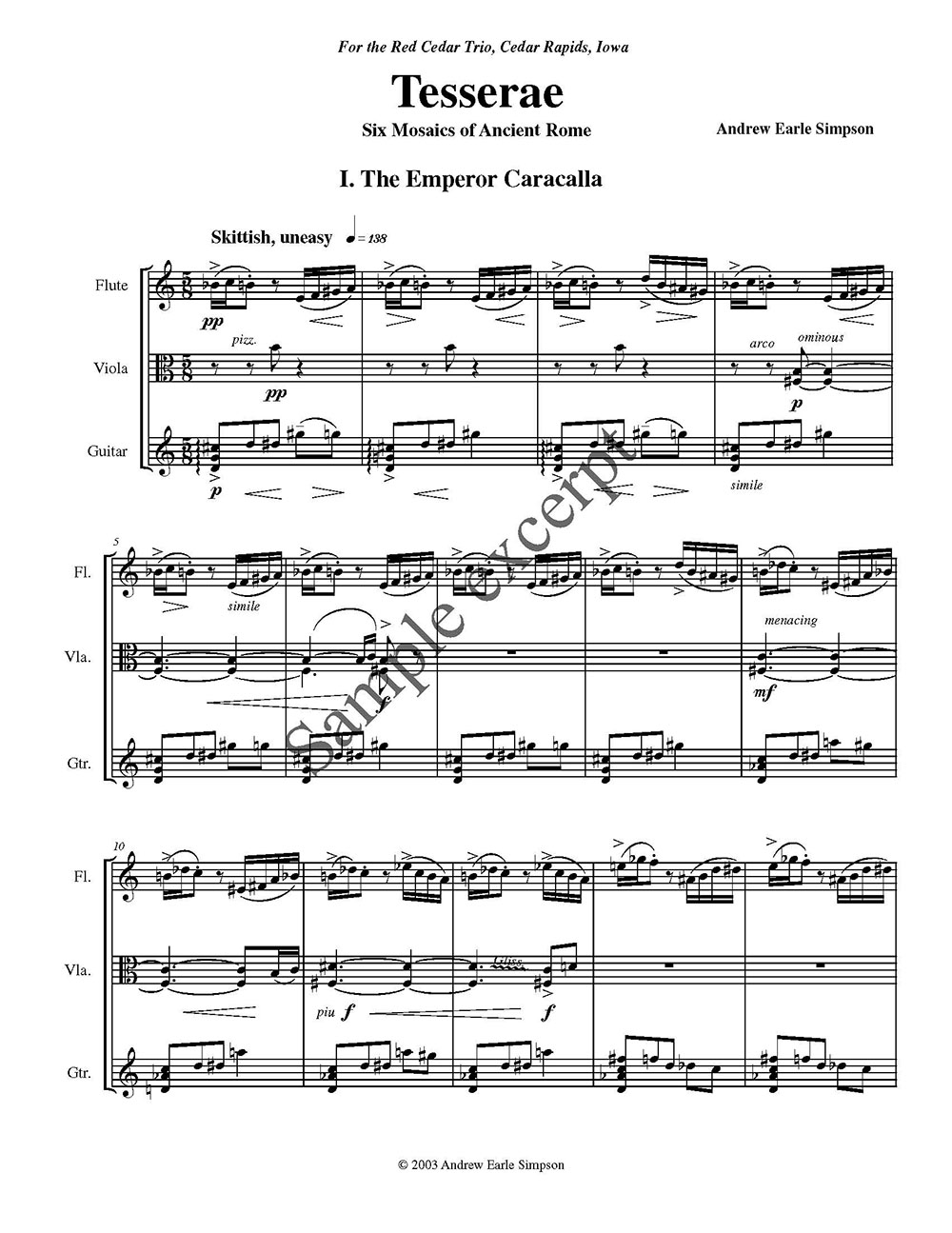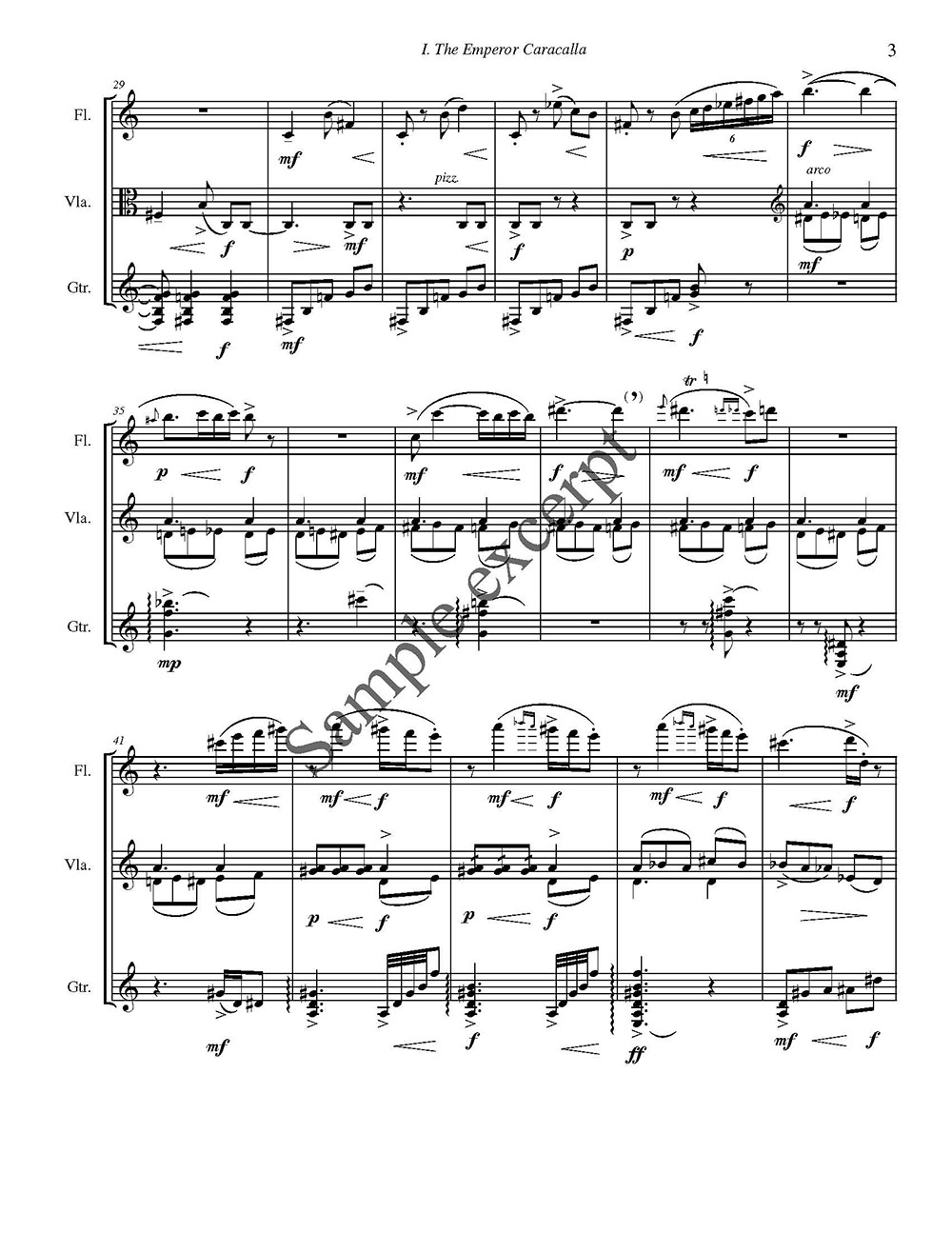"Simpson demonstrates a real understanding of the instruments he is writing for, and the harmonic language is tonal with a contemporary bite..."
— The Flutist Quarterly
Tesserae: Six Mosaics of Ancient Rome (2003-04)
for flute, viola, and guitar, 15 minutes
Instrumentation
flute, viola, guitar
Recording
Fireflies: Chamber Music by Andrew Earle Simpson/Red Cedar Trio (Fleur de Son Classics, 2009)
A suite based on specific ancient Roman artworks. Commissioned by the American Composers Forum as part of its “Museums, Composers, and Communities” residency program (for the Cedar Rapids Museum of Art’s exhibition, “Art in Roman Life: Villa to Grave”, 2003-05)
Movements:
I. The Emperor Caracalla
II. Geta, the Youth
III. The Syrian Woman
IV. Banqueting Music
V. Funeral March and Oration
VI. Coda: Apotheosis
Listen
I. Caracalla (excerpt)
II. Geta, the Youth (excerpt)
III. The Syrian Woman (excerpt)
IV. Banqueting Music (excerpt)
Program Notes
“Tesserae” are tiny glass or stone pieces used in mosaics. This chamber work, subtitled “Six Mosaics of Ancient Rome,” is a series of six miniature portraits of historical figures or scenes of ancient Roman life. The present work, created on a commission from the American Composers Forum and the Red Cedar Trio, was composed as part of my composer residency with the Cedar Rapids Museum of Art’s exhibition “Art in Roman Life: Villa to Grave.”
The first three movements are inspired directly by ancient Roman busts housed in the collection of the Cedar Rapids Museum of Art: in effect, they are “character sketches” of the individuals as portrayed in their busts.
An interesting historical narrative grew, by sheer chance, from two of the busts housed in the museum’s collection. The first two movements depict Caracalla, Roman Emperor from 211-217 AD, and Geta, his brother. The two were sons of the Emperor Septimius Severus. Caracalla, the older brother, was initially named as Severus’ heir; later, Severus named Geta as co-Emperor with Caracalla. This uneasy arrangement lasted for a few months, at which point Caracalla had Geta assassinated. The contrasting characters of the busts in the exhibition - a glowering, mature Caracalla opposed to a naïve, youthful Geta – provided an excellent point of departure. Whereas Caracalla’s music, in 5/8, is angular and dissonant, Geta’s music, in 6/8, is gentle, playful, and firmly on a C-major tonality. Near the end of the second movement, Caracalla’s music returns; the two themes combat, and Caracalla’s music “kills” Geta’s music.
The third movement is based on the bust of an unknown Syrian Woman, perhaaps taken from the exterior of an ancient tomb in Syria. The bust is remarkable both for its material, which is limestone rather than marble, and the melancholy, faraway expression on the woman’s face, highlighted by the pose. The figure is resting her head in her hands – a remarkable position – and the fingers of the right hand may be seen on the character’s right cheek. This slow third movement is the emotional centerpiece of the work. Its melodic style and texture is greatly influenced by Middle Eastern music, as the very ornamented melodic lines, heterophonic textures, drone notes, and drumming with fingers (golpe) on the body of the guitar indicate.
The final three movements are played without pause. “Banqueting Music” is based on an ancient Greek rhythm (one also employed by the Romans) called an Anacreontic. This very lively rhythm has an additional connection in that the ancient Greek lyric poet, Anacreon, after which the rhythm was named, is largely known for his extant poems on wine! The banqueting music is boisterous and rowdy; as it reaches its peak, it is suddenly cut short by a funeral procession: Geta’s funeral procession.
Guitar tremolo figures evoke a muffled drum, as the funeral procession wends its way toward the public square (forum) in which an orator would deliver a eulogy. Heard above the texture is a drawn-out variant of Caracalla’s music, given in such a way to say that although he is in attendance at his brother’s funeral, he is innocent of his death. Upon arrival at the forum, the viola gives a long-winded, slightly pompous oration, under which the funeral march music may still be heard. Near the end of this movement, the music slows and becomes more serene: the flute and viola wend higher and higher in their registers.
An “apotheosis” refers to the divinization of a human being, in this case, Geta. The final movement represents Geta’s apotheosis, and also draws upon a common ancient Roman image: eternal banqueting in the afterlife. The banqueting music of movement IV returns, though changed (the viola plays sul ponticello and pianissimo), and the flute is heard to play an altered version of Geta’s theme. The texture of the work’s closing sounds distant, as if the music is heard through a veil.
—Andrew Earle Simpson


